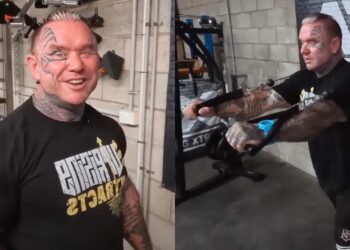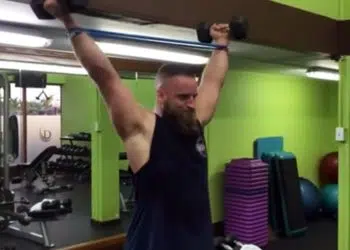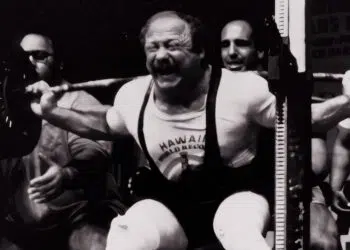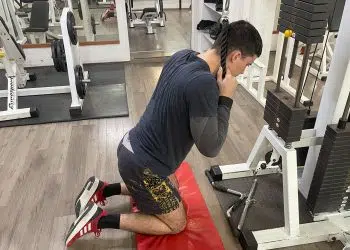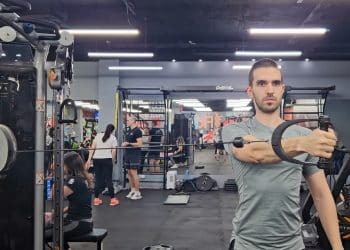I’ve been strength training since my mid-teens and a professional personal trainer since my early 20s. During that time, I’ve tried every type of exercise you can think of. I’ve done them all, from freeweights to kettlebells to resistance bands to body weight.
While each one offers advantages and disadvantages, I believe they all deserve a place in your workouts. That said, if you forced me to choose a single training method, I’d probably pick cables.
Cable machines work your muscles like freeweights with the convenience of machines. Give me a good cable machine, and I can show you how to train every muscle in the human body while being kind to your joints.
One of my all-time favorite cable machine exercises is the cable good morning. This bad boy provides an intense workout for your glutes and hamstrings while being easy on your lower back. It also drills that all-important hip hinge movement that studies tell us is so critical for avoiding lower back pain (1).
So, in this article, I explain how and why to do this great exercise and share my top tips for making it even more effective.
How to Do Cable Good Mornings & Correct Form
While cable good mornings are easier to learn and put less stress on your back than barbell good mornings, your form still matters. Consequently, using the correct form for this exercise will make it more effective and bring your risk of injury down to zero. So, follow this step-by-step guide to doing perfect cable good mornings.
Level Up Your Fitness: Join our 💪 strong community in Fitness Volt Newsletter. Get daily inspiration, expert-backed workouts, nutrition tips, the latest in strength sports, and the support you need to reach your goals. Subscribe for free!
- Attach a rope handle or straight bar to a low cable machine. Select an appropriate weight.
- Pick up your chosen handle and step back to tension the cable. Brace your core and pull your shoulders back and down.
- Stand with your feet between hip and shoulder-width apart and extend your arms in front of you.
- Push your butt backward and hinge forward from the hips. Lean as far as your flexibility allows, getting a good stretch in your hamstrings.
- Drive your hips forward and stand up straight.
- Continue for the required number of reps.
Cable Good Mornings: Muscles Worked
Cable good mornings are a compound exercise. As such, they involve multiple joints and work several muscles. The main muscles trained during cable good mornings are:
- Gluteus maximus
- Hamstrings
- Erector spinae
- Core
- Trapezius and rhomboids
- Forearms
Pro-Trainer Tips
Get more from cable good mornings with these tried-and-tested pro-trainer tips!
- Shift your weight back onto your heels to maximize hamstring engagement.
- Keep your chest up and lower back slightly arched to work your glutes more.
- Keep your chin tucked in and your neck long to optimize your posture.
- Experiment with wider and narrower stances to see what works best for you.
- Change the height of the cable to work the target muscles from different angles.
- Try resting your toes on weight plates to increase hamstring recruitment even more.
Cable Good Morning Mistakes to Avoid
Make cable good mornings as safe as possible by avoiding these common mistakes.
- Rounding your lower back. This is arguably the worst thing you can do during any forward flexion exercise. It can cause severe back injury, so don’t do it!
- Leaning forward too fast. Get the most out of every rep by lowering the weight more slowly than you lift it. Try lowering in three and lifting in one second.
- Shifting your weight onto your toes. This mistake takes tension away from the target muscles. Keep your weight on your heels.
- Bending your arms. This is a lower-body exercise, not an arm exercise! Think of your arms as extensions of the cable machine. Keep them straight throughout.
- Rounding your shoulders. Protect your shoulders and practice good posture by pinching your shoulder blades back and together. Don’t allow them to get pulled forward.
Cable Good Morning Benefits
Not sure if cable good mornings deserve a place in your workouts? Consider these benefits and then decide.
Less lower back stress
While I love regular barbell good mornings, the cable version is easier on your lower back. In fact, you may not even feel your lower back working during this exercise. That’s good news for back pain sufferers, and when you want to work your posterior chain without overloading your erector spinae, e.g., after squats or deadlifts.
Drill your hip hinge
The hip hinge is a critical movement that every exerciser needs to master. It’s an essential part of many movements, including squats, Romanian deadlifts, bent-over rows, and kettlebell swings.
The cable good morning is not just a valuable strengthening exercise; it’s also a good teaching tool for learning to hip hinge correctly. Use it to practice this all-important movement.
Constant tension on your glute and hamstrings
Unlike conventional good mornings, where the stress on your muscles drops to almost zero when you stand up, cable good mornings keep your muscles under constant tension. With no “dead spots,” cable good mornings are potentially more effective than the freeweight version.
Level Up Your Fitness: Join our 💪 strong community in Fitness Volt Newsletter. Get daily inspiration, expert-backed workouts, nutrition tips, the latest in strength sports, and the support you need to reach your goals. Subscribe for free!
Ideal for drop sets
Drop sets are a great way to increase the intensity of your workouts. Simply rep out to failure, reduce the weight by 10-15%, and rep out again. Drop sets are an effective way to make your workouts more time-efficient, as you can fatigue your muscles with fewer sets. Freeweight good morning drop sets are impractical, as it takes too long to reduce the load.
More forgiving than freeweight good mornings
While I like conventional good mornings, I know that some of my clients find them uncomfortable and even intimidating. These worries vanish with the cable version. Also, you won’t be punished so severely for minor form errors. That’s not the case with the barbell version, where even small mistakes can cause big problems.
Cable Good Morning Programming
Cable good mornings are not a good exercise for heavy weights and low reps. The barbell version is better for that purpose. Instead, the best way to do cable good mornings is with light to moderate weights and medium to high reps. Sets of 8-15 are an ideal place to start for most people. That said, you can go as high as 20-30 reps if you prefer to train with lighter loads or are coming back from injury.
Do cable good mornings 1-3 times a week on non-consecutive days. 2-4 sets should be enough to fatigue the target muscles, resting 1-2 minutes between efforts.
Cable Good Morning Variations
Like any exercise, cable good mornings can become boring and lose some of their effectiveness if you do them too often. So, keep your posterior training interesting and productive with my three favorite cable good morning variations.
Seated cable good mornings
Seated good mornings take some of the tension out of your hamstrings so you can lean further forward and work your glutes a little more. They’re also a good option for those of us with tight hammies. In addition, they’re a valuable exercise for injured exercisers who cannot stand, e.g., while recovering from an ankle or knee issue.
Dual cable good mornings
Some cable machines have twin pulleys, which can be connected using a bar. This makes them ideal if you want to do conventional good mornings but prefer to train with cables. Not all gyms have these machines, but they’re an excellent exercise if you have access to one.
Cable Zercher good mornings
The Zercher good morning involves holding the bar in the crooks of your elbows. With the weight closer to your body, there is even less stress on your lower back. This is a real benefit for many exercisers, including those with pre-existing lower back issues. On the downside, Zercher good mornings can be uncomfortable for your arms.
Closing Thoughts
Cable good mornings are a valuable alternative to the traditional barbell version. They keep your muscles under tension for longer and are far easier on your lower back. This is also an excellent exercise for intensity-boosting drop sets.
On the downside, they’re not the best exercise for building brute strength, as they don’t work well with heavy weights and low reps. However, that’s not much of an issue unless you are training for powerlifting.
I heartily recommend cable good mornings. They’re one of my clients’ favorite posterior chain exercises, and I reckon you’ll like them, too!
References:
- Michaud F, Pérez Soto M, Lugrís U, Cuadrado J. Lower Back Injury Prevention and Sensitization of Hip Hinge with Neutral Spine Using Wearable Sensors during Lifting Exercises. Sensors (Basel). 2021 Aug 14;21(16):5487. doi: 10.3390/s21165487. PMID: 34450929; PMCID: PMC8402067.3
Featured image: @fitdaniluu3602 on YouTube
Interested in measuring your progress? Check out our strength standards for Good Morning, Deadlift, Romanian Deadlift, and more.



